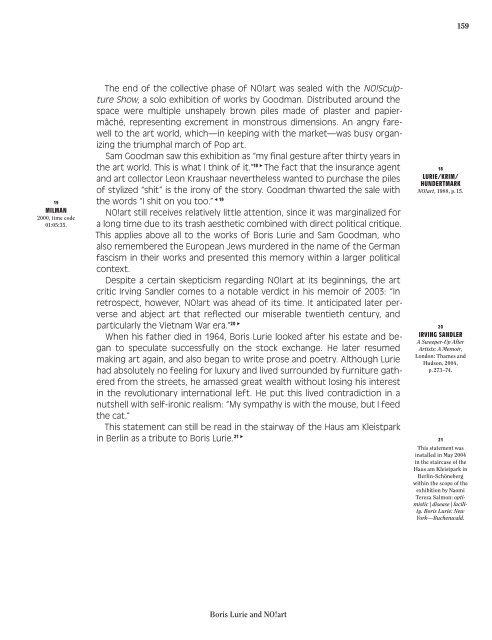The Art of
1WQggTh
1WQggTh
You also want an ePaper? Increase the reach of your titles
YUMPU automatically turns print PDFs into web optimized ePapers that Google loves.
159<br />
19<br />
MILMAN<br />
2000, time code<br />
01:05:35.<br />
<strong>The</strong> end <strong>of</strong> the collective phase <strong>of</strong> NO!art was sealed with the NO!Sculpture<br />
Show, a solo exhibition <strong>of</strong> works by Goodman. Distributed around the<br />
space were multiple unshapely brown piles made <strong>of</strong> plaster and papiermâché,<br />
representing excrement in monstrous dimensions. An angry farewell<br />
to the art world, which—in keeping with the market—was busy organizing<br />
the triumphal march <strong>of</strong> Pop art.<br />
Sam Goodman saw this exhibition as “my final gesture after thirty years in<br />
the art world. This is what I think <strong>of</strong> it.” 18 <strong>The</strong> fact that the insurance agent<br />
and art collector Leon Kraushaar nevertheless wanted to purchase the piles<br />
<strong>of</strong> stylized “shit” is the irony <strong>of</strong> the story. Goodman thwarted the sale with<br />
the words “I shit on you too.” 19<br />
NO!art still receives relatively little attention, since it was marginalized for<br />
a long time due to its trash aesthetic combined with direct political critique.<br />
This applies above all to the works <strong>of</strong> Boris Lurie and Sam Goodman, who<br />
also remembered the European Jews murdered in the name <strong>of</strong> the German<br />
fascism in their works and presented this memory within a larger political<br />
context.<br />
Despite a certain skepticism regarding NO!art at its beginnings, the art<br />
critic Irving Sandler comes to a notable verdict in his memoir <strong>of</strong> 2003: “In<br />
retrospect, however, NO!art was ahead <strong>of</strong> its time. It anticipated later perverse<br />
and abject art that reflected our miserable twentieth century, and<br />
particularly the Vietnam War era.” 20<br />
When his father died in 1964, Boris Lurie looked after his estate and began<br />
to speculate successfully on the stock exchange. He later resumed<br />
making art again, and also began to write prose and poetry. Although Lurie<br />
had absolutely no feeling for luxury and lived surrounded by furniture gathered<br />
from the streets, he amassed great wealth without losing his interest<br />
in the revolutionary international left. He put this lived contradiction in a<br />
nutshell with self-ironic realism: “My sympathy is with the mouse, but I feed<br />
the cat.”<br />
This statement can still be read in the stairway <strong>of</strong> the Haus am Kleistpark<br />
LURIE/KRIM/<br />
HUNDERTMARK<br />
NO!art, 1988, p. 15.<br />
20<br />
IRVING SANDLER<br />
A Sweeper-Up After<br />
<strong>Art</strong>ists: A Memoir,<br />
London: Thames and<br />
Hudson, 2004,<br />
p. 273–74.<br />
18<br />
in Berlin as a tribute to Boris Lurie. 21 21<br />
This statement was<br />
installed in May 2004<br />
in the staircase <strong>of</strong> the<br />
Haus am Kleistpark in<br />
Berlin-Schöneberg<br />
within the scope <strong>of</strong> the<br />
exhibition by Naomi<br />
Tereza Salmon: optimistic<br />
| disease | facility.<br />
Boris Lurie: New<br />
York—Buchenwald.<br />
Boris Lurie and NO!art


